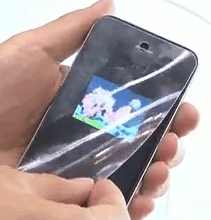| Pic3D - no glasses 3D on any device |
| Written by Harry Fairhead | |||
| Sunday, 03 July 2011 | |||
|
A low-cost solution for 3D display means a new lease of life for 3D games and other apps. Now you don't need to buy a custom 3D display or device, you can simply stick some plastic film over it. It's cheap and it's tacky — literally(!) — and it might be the 3D solution we have have been looking for. While it is true that the enthusiasm for 3D movies and TV is already declining, if there ever was much enthusiasm, there is a lot of scope for exploiting 3D in games and other applications. A Japanese company, Pic3D, has produced a range of lenticular films that you can simply stick on the front of an LCD display. The film reduces the screen's brightness about 90% and currently you can buy versions for 23 to 15.6 inch monitors and for the iPhone, iPad and iPod. The largest sheets cost around $180 and the phone size ones are about $25. The company claims a 120-degree viewing angle.
The sheets come complete with some software that allows you to view still images or videos in side-by-side format in 3D. Side-by-side format simply uses half the available resolution to present a left and a right eye version of the scene next to each other in the same frame, i.e. side-by-side. The software then takes the side-by-side input, splits it up, and stitches it together so that each eye sees only the view intended for it. The lenticular screen ensures that each eye only sees the part of the image that corresponds to its view point. The film works in the same way as other non-glasses-based 3D devices such as the Nintendo 3DS - so this is no breakthrough. What it does is provide a way to get the 3D effect on any screen without having to buy a new device and it means you can consider adding optional 3D to an app, safe in the knowledge that your users can afford it if they want it. You can see it in action, admittedly not very clearly, in the video below:
At the moment there is no release date for the rest of the world and there is no published API that allows you to make use of the film in your own applications. However, given the basic principles of the way lenticular film works to create 3D, it shouldn't be difficult to create your own display software with the help of a 3D package such as OpenGL or DirectX. So your next task is to think up something compelling in 3D. More Information:
If you would like to be informed about new articles on I Programmer you can either follow us on Twitter or Facebook or you can subscribe to our weekly newsletter.
|
|||
| Last Updated ( Sunday, 03 July 2011 ) |

